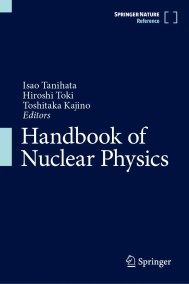谷畑勇夫・土岐博・梶野敏貴(共)編/ 核物理学ハンドブック(全5巻)
核物理学の革命的進歩の成果を体系的に示す包括的レファレンス刊行!
谷畑勇夫・土岐博・梶野敏貴(共)編/核物理学ハンドブック(全5巻)
Handbook of Nuclear Physics

Editors: Isao Tanihata, Hiroshi Toki, Research Center for Nuclear Physics, Osaka University, Ibaraki, Japan & Toshitaka Kajino, Beihang University, Haidan, China
2023:09 5 vols. 4,207 p. 1,499 illus., 1,098 in color ISBN 978-981-19-6344-5 (Springer) -DE-
EUR 1499.99
Web販売価格:税込¥284,589 / 標準価格:税込¥367,946
*2024年7月30日時点の価格です。実際の価格は、為替レートや出版社の都合により変動いたしますので、最新の価格は以下オンラインストアリンクをご参照ください。
*Web販売価格は、紀伊國屋書店BookWeb Proでご注文され、付帯作業を伴わない納品を行い、弊社標準書式による請求書を発行し遅滞なくお支払いただく場合、あるいは、クレジットカードでお支払いいただく場合に適用される販売価格です。
概要
1980年後半以降、不安定な放射性同位体を加速させることのできるイオンビームの登場により、核物理学は革命的な進歩を遂げました。本書の編集主幹である谷畑勇夫(大阪大学核物理センター特任教授)は、指導教官の杉本健三のもとで、当時カリフォルニア大学内のローレンス・バークレー国立研究所でのイオンビームを用いた実験に取り組み、その方法論を発展させました。それ以前、加速することのできる粒子は、地球上に存在する安定的な原子核と素粒子に限られていました。イオンビームの登場で不安定核を実験に用いることが可能になり、核崩壊の過程や生成する素粒子を観測し、理論上想定されていた物理学の標準モデルの検証が国際的に進んでいます。
本書は、現代の核物理学の包括的かつ体系的な知識を提示するハンドブックです。全5巻、16部、113章にて、核物理学における理論と実験にわたる最新の知見および宇宙物理学の関連トピックを紹介します。斯界の権威が各部の編集と解説を担当し、日本を含む世界中の卓越した研究者が寄稿した多数の章をまとめあげています。
核物理学や素粒子論、宇宙物理学を研究する皆様へ、本書をおすすめいたします。
価格照会・ご購入
- 紀伊國屋書店でご購入(一般の方向け):紀伊國屋書店ウェブストア
- 紀伊國屋書店でご購入(法人の方向け):紀伊國屋書店BookWeb Pro
※本件についてのお問い合わせ、お見積りについては最寄りの紀伊國屋書店営業所もしくはこちらまでお願いいたします。
収録明細
Volume 1
Section I Exotic Nuclei: Production, Separation, Masses, and Lifetimes (Hans Geissel)
- Exotic Nuclei and Their Separation, Electromagnetic Devices (Hans Geissel and D. J. Morrissey)
- Exotic Nuclei and Their Separation, Using Atomic Interactions (Hans Geissel and D. J. Morrissey)
- Reactions for Production of Exotic Nuclei (N. Antonenko, J. Benlliure, A. Karpov, and D. J. Morrissey)
- Masses of Exotic Nuclei (Klaus Blaum, Sergey Eliseev, and Stephane Goriely)
- Lifetimes of Exotic Nuclei (I. Mukha, H. Koura, and T. Tachibana)
Section II Static Properties and Decays (Juha Äystö)
- Matter Radii and Density Distributions (Akira Ozawa)
- Nuclear Charge Radii (W. Nörtershäuser and I. D. Moore)
- Spins and Electromagnetic Moments of Nuclei (Ruben P. de Groote and Gerda Neyens)
- Beta Decay: Probe for Nuclear Structure and the Weak Interaction (B. Rubio, W. Gelletly and O. Naviliat-Cuncic)
- Charged-Particle Radioactive Decays (B. Blank and R. D. Page)
- Heaviest Elements: Decay and Laser Spectroscopy (Michael Block, Sebastian Raeder, and Rolf-Dietmar Herzberg)
- Nuclear Isomers (Philip M. Walker and Zsolt Podolyák)
- In-Beam Spectroscopy of Nuclear Electromagnetic Transitions (A. Görgen and W. Korten)
Section III Dynamical Properties (Muhsin N. Harakeh)
- Theoretical Methods for Giant Resonances (Gianluca Colò)
- Experimental Techniques in Study of Giant Resonances: Magnetic Spectrometers (Mamoru Fujiwara)
- Isoscalar Giant Resonances: Experimental Studies (Umesh Garg)
- Theoretical Description of Pygmy (Dipole) Resonances (Edoardo G. Lanza and Andrea Vitturi)
- Pygmy Dipole Resonance: Experimental Studies by Different Probes (Andreas Zilges and Deniz Savran)
- Excitation of Isovector Giant Resonances Through Charge-Exchange Reactions (Remco G. T. Zegers)
Volume 2
Section IV Fission of Nuclei (Peter G. Thirolf)
- The Multi-humped Fission Barrier (Andreas Oberstedt and Stephan Oberstedt)
- Microscopic Theory of Nuclear Fission (Nicolas Schunck)
- Photofission Studies: Past and Future (Lorant Csige and Dan Mihai Filipescu)
- Multinucleon-Transfer-Induced Fission (Katsuhisa Nishio)
- The Fission Barrier of Heaviest Nuclei from a Macroscopic-Microscopic Perspective (Michał Kowal and Janusz Skalski)
Section V Halo and Unstable Nuclei (Isao Tanihata)
- Halo Nuclei (Isao Tanihata and Björn Jonson)
- Theory of Halo Nuclei (H.-W. Hammer)
- Beta Decay of Halo Nuclei (Karsten Riisager)
- Radii and Momentum Distribution of Unstable Nuclei (Rituparna Kanungo)
- Low-Energy Reactions with Halo Nuclei (C. Signorini, M. Mazzocco, and D. Pierroutsakou)
- Coulomb Breakup and Soft E1 Excitation of Neutron Halo Nuclei (Takashi Nakamura)
- Unbound Nuclei (Haik Simon)
- Magic Numbers Off the Stability Line (Tohru Motobayashi)
- Nuclei Near and at the Proton Dripline (Marek Pfützner and Chiara Mazzocchi)
Section VI Nuclear Reaction for Structure Studies (Carlos A. Bertulani)
- Indirect Methods in Nuclear Astrophysics with Transfer Reactions (Aurora Tumino and Stefan Typel)
- Probing Nuclear Structure with Photon Beams (Johann Isaak and Norbert Pietralla)
- Direct Nuclear Reactions (Carlos A. Bertulani and Angela Bonaccorso)
- Theoretical Studies of Low-Energy Nuclear Reactions (Pierre Descouvemont)
- Influence of Nuclear Structure in Relativistic Heavy-Ion Collisions (Yu-Gang Ma and Song Zhang)
- Modern Approaches to Optical Potentials (Jeremy W. Holt and Taylor R. Whitehead)
- Ab Initio Nuclear Reaction Theory with Applications to Astrophysics (Petr Navrátil and Sofia Quaglioni)
- Electron Scattering Off Stable and Unstable Nuclei (Toshimi Suda)
- Sub-barrier Fusion Reactions (K. Hagino)
Volume 3
Section VII Nucleon-Nucleon Interactions (Ruprecht Machleidt)
- NN Experiments and NN Phase-Shift Analysis (Enrique Ruiz Arriola and Rodrigo Navarro Pérez)
- Phenomenology and Meson Theory of Nuclear Forces (Ruprecht Machleidt)
- Quark Models for Baryon-Baryon Interactions (P. G. Ortega, D. R. Entem, and F. Fernández)
- Lattice QCD and Baryon-Baryon Interactions (Sinya Aoki and Takumi Doi)
- Local Two- and Three-Nucleon Interactions Within Chiral Effective Field Theory (Maria Piarulli, Jason Bub, and Ingo Tews)
- Semi-local Nuclear Forces from Chiral EFT: State-of-the-Art and Challenges (Evgeny Epelbaum, Hermann Krebs, and Patrick Reinert)
- Nonlocal Chiral Nuclear Forces up to N5LO (D. R. Entem, Ruprecht Machleidt, and Y. Nosyk)
- Nucleon-Antinucleon Interaction (Jean-Marc Richard Section)
Section VIII Models of Nuclear Structure (Jie Meng)
- Model for Independent Particle Motion (A. V. Afanasjev)
- Model for Collective Motion (Z. P. Li and D. Vretenar)
- Models for Pairing Phenomena (Xiang-Xiang Sun and Shan-Gui Zhou)
- Algebraic Models of Nuclei (P. Van Isacker)
- Nuclear Density Functional Theory (DFT) (Gianluca Colò)
- Relativistic Density Functional Theories (Jie Meng and Pengwei Zhao)
- Model for Collective Vibration (Haozhao Liang and Elena Litvinova)
- Configuration Interaction Approach to Atomic Nuclei: The Shell Model (Yusuke Tsunoda and Takaharu Otsuka)
- Symmetry Restoration Methods (Jiangming M. Yao)
- Quantum Microscopic Dynamical Approaches (Cédric Simenel)
Section IX Tensor Interaction in Nuclei (Hiroshi Toki)
- Hadrons from Quarks and Chiral Symmetry (Atsushi Hosaka)
- Pion Exchange Interaction in Bonn Potential and Relativistic and Non-relativistic Framework in Nuclear Matter (Jinniu Hu and Chencan Wang)
- Extended Hartree-Fock Theory with Strong Tensor Correlation and the Tensor-Optimized Shell Model (Hiroshi Toki)
- Measurements of NN Correlations in Nuclei (E. I. Piasetzky and L. B. Weinstein)
- Many-Body Correlations in Light Nuclei with the Tensor-Optimized Antisymmetrized Molecular Dynamics (Takayuki Myo)
- Effects of Tensor Interactions in Nuclei (Isao Tanihata)
Volume 4
Section X Mesonic- and Hypernuclei (Emiko Hiyama)
- What Is Hypernuclear Physics and Why Studying Hypernuclear Physics Is Important (Emiko Hiyama and Benjamin F. Gibson)
- High-Precision γ-Ray Spectroscopy of Δ Hypernuclei (Hirokazu Tamura)
- Σ Hypernuclei (Tomofumi Nagae)
- Experimental Aspect of S = −2 Hypernuclei (Kazuma Nakazawa)
- Theoretical Studies in S = −1 and S = −2 Hypernuclei (Emiko Hiyama and Benjamin F. Gibson)
- Theoretical Study of Deeply Bound Pionic Atoms with an Introduction to Mesonic Nuclei (Satoru Hirenzaki and Natsumi Ikeno)
- Pionic Atoms in Experiment (Kenta Itahashi)
- Kaonic Nuclei from the Experimental Viewpoint (Masahiko Iwasaki)
- Theory of Kaon-Nuclear Systems (Tetsuo Hyodo and Wolfram Weise)
- The η- and η-Nucleus Interactions and the Search for η, η – Mesic States (Steven D. Bass, Volker Metag, and Pawel Moskal)
Section XI Quark Nuclear Physics (Hideo Suganuma)
- Quantum Chromodynamics, Quark Confinement, and Chiral Symmetry Breaking: A Bridge Between Elementary Particle Physics and Nuclear Physics (Hideo Suganuma)
- Spontaneous Breaking of Chiral Symmetry in QCD (Yoshimasa Hidaka)
- QCD Vacuum as Dual Superconductor: Quark Confinement and Topology (Maxim Chernodub)
- Quark Nuclear Physics for Hadrons and Nuclei in the Dual Ginzburg-Landau Theory (Hiroshi Toki)
- Quark Nuclear Physics with Heavy Quarks (Nora Brambilla)
- Generalization of Global Symmetry and Its Applications to QCD-Related Physics (Yuya Tanizaki)
- Chiral Magnetic Effect: A Brief Introduction (Dmitri E. Kharzeev)
- Crossover Between Quark Nuclear Matter and Condensed-Matter Physics (Tomáš Brauner and Naoki Yamamoto)
- Hadrons, Quark-Gluon Plasma, and Neutron Stars (Akira Ohnishi)
Volume 5
Section XII Cosmic and Galactic Chemical Evolution (Toshitaka Kajino)
- Equation of State in Neutron Stars and Supernovae (Kohsuke Sumiyoshi, Toru Kojo, and Shun Furusawa)
- Galactic Chemical Evolution, Astronomical Observation from Metal-Poor Stars to the Solar System (Wako Aoki and Miho N. Ishigaki)
- Chemo-dynamical Evolution of Galaxies (Chiaki Kobayashi and Philip Taylor)
- Cosmic Radioactivity and Galactic Chemical Evolution (Roland Diehl and Nikos Prantzos)
Section XIII Nuclear and Particle Processes in Big Bang Cosmology (Grant J. Methews)
- Overview of Big Bang Cosmology (Grant J. Mathews and Guobao Tang)
- Big Bang Thermodynamics and Cosmic Relics (Grant J. Mathews and Guobao Tang)
- Big Bang Nucleosynthesis: Nuclear Physics in the Early Universe (Brian D. Fields)
- Inflation, Perturbations, and Structure Formation (Grant J. Mathews and Guobao Tang)
Section XIV Evolution of Stars and Nucleosynthesis (Ken’ichi Nomoto)
- Nuclear Reactions in Evolving Stars (and Their Theoretical Prediction) (Friedrich-Karl Thielemann and Thomas Rauscher)
- Experimental Nuclear Astrophysics (Michael Wiescher, Richard James deBoer, and René Reifarth)
- Slow Neutron-Capture Process in Evolved Stars (Raphael Hirschi)
- Weak Interactions in Evolving Stars (Toshio Suzuki)
- Stellar Evolution and Nuclear Reaction Rate Uncertainties (Ken’ichi Nomoto and Wenyu Xin)
- Thermal Evolution of Neutron Stars (Sachiko Tsuruta and Ken’ichi Nomoto)
Section XV Neutrino Processes in Astrophysics (Akif Baha Balantekin)
- Neutrino Charged and Neutral Current Opacities in the Decoupling Region (Ermal Rrapaj and Sanjay Reddy)
- Nuclear Physics Constraints on Neutrino Astrophysics (Myung-Ki Cheoun, Kyungsik Kim, Eunja Ha, Heamin Ko, and Dukjae Jang)
- Big Bang Nucleosynthesis (Evan Grohs and George M. Fuller)
- Neutrinos and Heavy Element Nucleosynthesis (Xilu Wang and Rebecca Surman)
- Many-Body Collective Neutrino Oscillations: Recent Developments (Amol V. Patwardhan, Michael J. Cervia, Ermal Rrapaj, Pooja Siwach, and Akif Baha Balantekin)
- Fast Flavor Transformations (Sherwood Richers and Manibrata Sen)
- Diffuse Supernova Neutrino Background (Anna M. Suliga)
Section XVI Supernovae and Neutron Star Mergers (Hans-Thomas Janka)
- Nucleosynthesis and Tracer Methods in Type Ia Supernovae (Ivo Rolf Seitenzahl and Rüdiger Pakmor)
- Nucleosynthesis in Neutrino-Heated Ejecta and Neutrino-Driven Winds of Core-Collapse Supernovae: Neutrino-Induced Nucleosynthesis (Shinya Wanajo)
- Nucleosynthesis in Jet-Driven and Jet-Associated Supernovae (Martin Obergaulinger and Moritz Reichert)
- R-Process Nucleosynthesis in Neutron Star Merger Ejecta and Nuclear Dependences (Stephane Goriely and Ina Kullmann)
- Observations of R-Process Stars in the Milky Way and Dwarf Galaxies (Anna Frebel and Alexander P. Ji)
- Dynamics and Equation of State Dependencies of Relevance for Nucleosynthesis in Supernovae and Neutron Star Mergers (Hans-Thomas Janka and Andreas Bauswein)
- Measurements of Radioactive 60Fe and 244Pu Deposits on Earth and Moon (Anton Wallner)
Index
(学術洋書部)





